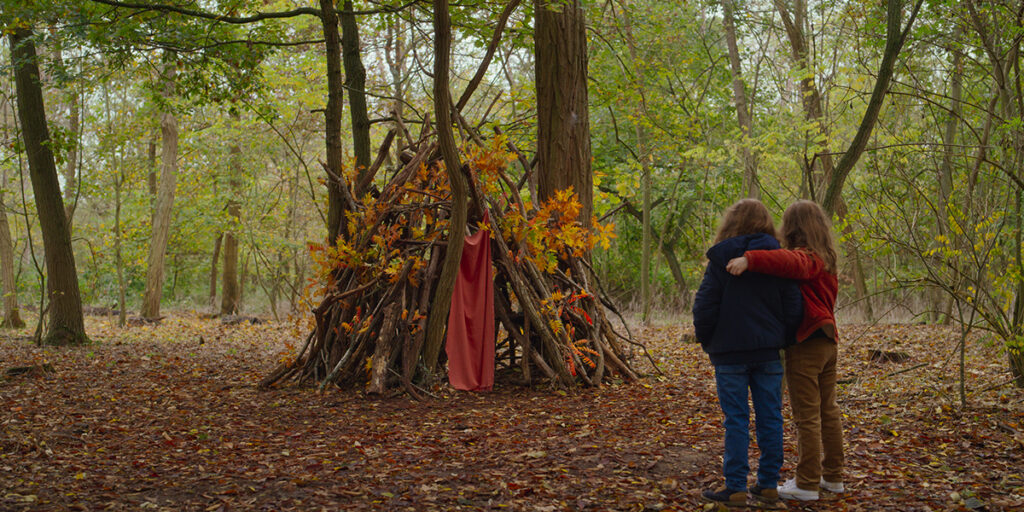In Céline Sciamma’s newest feature, Petite Maman, for the first time, mother and daughter speak the same language and play the same games—perhaps discovering that they understood each other all along.

This is one in a series of reviews from the 2021 Toronto International Film Festival (TIFF), during which I focused on films directed by women; you can find my other TIFF 2021 reviews here.
In some ways, to merely describe the premise of Céline Sciamma’s newest feature, Petite Maman, and reveal the strange and beautiful conceit upon which its narrative rests, is to do the film a disservice. Not because the premise itself exposes any kind of deficit in the film itself—far from it—but rather because it is so deceptively simple that it belies the complexity and depth of emotion Sciamma draws out of a pair of exquisite young actors, an old family home, and a beloved-but-lonely forest.
When the film begins, 8-year-old Nelly (Joséphine Sanz) has just lost her grandmother, and quiet conversations and interactions with her mother, Marion (Nina Meurisse), offer a touching reflection on what it means to say goodbye and how children and adults process grief. Nelly is serene and forthright, exhibiting a child’s acceptance and sincerity. But an understandable pallor of sadness hangs over the family as Nelly, her mother, and her father (Stéphane Varupenne) arrive at the grandmother’s home and begin to pack up her belongings and the remains of Marion’s childhood there many years before.
Nelly shares with her mother her sadness over her grandmother’s death, as well as her deepest regret: that she didn’t get to say a proper goodbye. Marion offers to let her daughter recreate the goodbye she would have given her grandmother had Nelly known she was going to die, and so Nelly intones a heartfelt farewell to her mother as proxy, and the two fall asleep in each other’s arms. The next morning, Marion is gone.
Nelly’s father explains that it was too difficult for her mother to stay; he and Nelly will finish packing on her behalf. Nelly eventually ventures into the surrounding forest in search of a lost ball—the same forest her mother has lovingly described as the site of a hut she built and played in as a child. Instead of the toy, she finds a girl her age (Gabrielle Sanz) building a beautiful branch-frame bower in the woods. Happy for a playmate, Nelly agrees to help, learning that the girl is named Marion like her mother.
When the two girls return to young Marion’s home for an afternoon treat, Nelly discovers that that it is an exact replica of her grandmother’s, except furnished and full of life. Here, the film divulges its secret: Young Marion is Nelly’s mother as a girl. Somehow, the path through the forest between the empty house and the occupied one allows the two girls to come together in a single place and time.
Rather than dwell on, or even attempt to explain, the mechanics of the time travel, both the film and the girls embrace the exceptional circumstances that allow mother and daughter this surprising and intimate connection without question. Marion anxiously awaits an important surgery, while Nelly knows she must soon return home with her family, but, for a few days, Nelly and Marion are able to be children together. Nelly is also able to see her grandmother again, in the younger form as Marion’s mother—finally getting the true goodbye she so craved.
On their last night together, Nelly sleeps over at Marion’s house, and the two girls talk about Marion’s future, the future that will ultimately bring Nelly into the world. Nelly also shares her grief, and her fear, that her mother will one day leave her for good. Mutually, the girls assure each other of their importance and worth, and Marion expresses longing for the daughter Nelly will become. In an especially touching exchange, Nelly observes astutely that the adult mother she knows often seems lost and overwhelmed , even before Nelly’s grandmother’s death, but young Marion comforts her; it’s not your fault, she tells Nelly, “You did not invent my sadness.”
As with her last film, Portrait of a Lady on Fire, Sciamma lingers on the tranquil slippages between solitude and togetherness, between longing and connection. For the first time, mother and daughter speak the same language and play the same games—perhaps discovering that they understood each other all along. Like the mind of a child, the film transitions easily between playful and somber moods, punctuated by the stillness of the house and the surrounding forest.
Carefully crafted through Sciamma’s writing and directing, beautifully shot by Claire Mathon (also Portrait’s cinematographer), and with an understated and bright performance by its two child actors, Petit Maman is an intimate and striking story about understanding, grief and love.
Up next:





